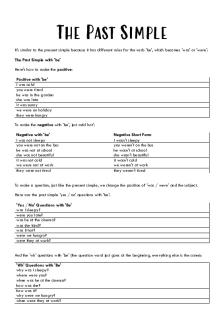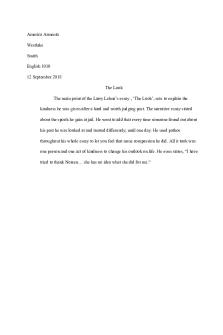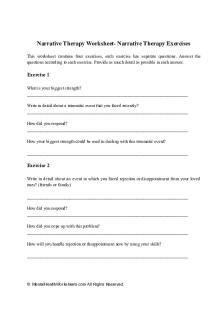Narrative Nurse\'s Note-Guideline PDF

| Title | Narrative Nurse\'s Note-Guideline |
|---|---|
| Course | Intro To Health Concepts |
| Institution | Fayetteville Technical Community College |
| Pages | 3 |
| File Size | 110.5 KB |
| File Type | |
| Total Downloads | 30 |
| Total Views | 145 |
Summary
Guidelines on how to document patient care in nursing...
Description
Charting Guidelines for Narrative/Annotated Documentation: The following information should be included in a narrative nurses’ note along with the full head-to-toe nursing assessment (may be included as an “annotated” note when computer charting): 1. Position/disposition of client (when you walked into the room) 2. Abnormal data from physical assessment/info that needs further explanation 3. Anything the client was not born with 4. Emergency or PRN equipment at the bedside 5. Client complaints/concerns or other important data disclosed by the client 6. Nurse response (to #5 above- what was done about it?)/ treatment interventions, if applicable. ***Be sure to SIGN ENTRY (initials ok, if initials/signature at bottom of page; or legal signature- first initial, last name, SN, NWCC) Position/disposition of client: (The person reading the note should immediately be able to get a visual picture of the client) i.e.
Lying in bed c eyes open.; Lying supine c eyes closed, resting quietly. (remember, never say “sleeping”); in chair at BS. (BS= bedside); Lying on L (or R) side; in bathroom; Ambulating in room c slow, steady gait noted.; Sitting in bed; on BSC (BSC= bedside commode).; Dangling at BS, etc.—You get the idea!
Abnormal data from physical assessment/info that needs further explanation: i.e.
Speech:
Nonverbal, though responds to some simple commands, such as handgrips, footpushes, etc.; Slow speech c simple one to two word responses noted.; Responds appropriately to questioning, though mumbling (or slurred or garbled speech) noted at times.
Motor:
Unable to move L upper et (et= and) lower extremities; R arm weak c limited handgrip noted; Bilat (Bilat= bilateral) LE’s (LE= lower extrem) partially (or fully) contracted.
Edema:
Trace (or 1+, 2+, 3+, or 4+) pitting (or nonpitting) edema noted to __________ (specify location—or document generalized edema. (generalized= “all over body”). *If unsure how swollen it is or if it is swollen at all, ask the patient or family if it is about normal size or if it appears swollen to them. (Can even explain the rating system to them and have them help you rate it—IF they are oriented!)
Bruises:
Approximate dime (or penny, nickel, quarter, half-dollar, golf ball, softball, baseball, etc.) sized bruise noted to __________(indicate specific location). *Try to list each bruise individually with approx. size and location, but if too many to count or chart, you can state: Multiple small (or medium or large) sized bruises noted to ___________, such as bilat. LE’s (or upper extremities). * Remember, the asterisk is to be placed in the “skin appearance” box, NOT “skin integrity” box!—May write the asterisk next to “W/D, cool/D”, etc.
Pulses:
Unable to palpate R pedal pulses due to presence of cast; Pedal pulses difficult to palpateskin pink et warm with cap refill...
Similar Free PDFs

Dosage Calculations for Nurses
- 8 Pages

Microbiology for Nurses 3053
- 103 Pages

Nurses Prayer AND Pledge
- 1 Pages

NARRATIVE REPORT
- 1 Pages

NARRATIVE REPORT
- 7 Pages

Literacy Narrative
- 5 Pages

Narrative Tenses
- 8 Pages

Black experience nurses
- 23 Pages

Nurses labs cram sheet
- 9 Pages

Narrative - adadsa
- 19 Pages

Santrockld 14 nurses guide intro
- 3 Pages

Nurses Refuse to Work-1
- 10 Pages

OJT Narrative Report
- 1 Pages

Narrative Analysis-English 1010
- 1 Pages

Narrative Essay Notes
- 10 Pages
Popular Institutions
- Tinajero National High School - Annex
- Politeknik Caltex Riau
- Yokohama City University
- SGT University
- University of Al-Qadisiyah
- Divine Word College of Vigan
- Techniek College Rotterdam
- Universidade de Santiago
- Universiti Teknologi MARA Cawangan Johor Kampus Pasir Gudang
- Poltekkes Kemenkes Yogyakarta
- Baguio City National High School
- Colegio san marcos
- preparatoria uno
- Centro de Bachillerato Tecnológico Industrial y de Servicios No. 107
- Dalian Maritime University
- Quang Trung Secondary School
- Colegio Tecnológico en Informática
- Corporación Regional de Educación Superior
- Grupo CEDVA
- Dar Al Uloom University
- Centro de Estudios Preuniversitarios de la Universidad Nacional de Ingeniería
- 上智大学
- Aakash International School, Nuna Majara
- San Felipe Neri Catholic School
- Kang Chiao International School - New Taipei City
- Misamis Occidental National High School
- Institución Educativa Escuela Normal Juan Ladrilleros
- Kolehiyo ng Pantukan
- Batanes State College
- Instituto Continental
- Sekolah Menengah Kejuruan Kesehatan Kaltara (Tarakan)
- Colegio de La Inmaculada Concepcion - Cebu
